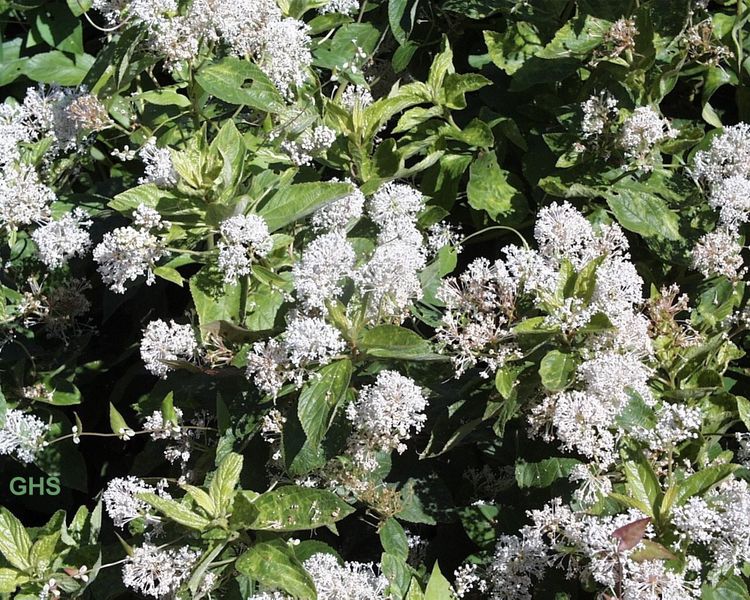 |
|
|
 |
| http://commons.wikimedia.org/wiki/File:Ceanothus_americanus_001.JPG |
Translate this page:
Summary
Bloom Color: White.
Main Bloom Time: Early spring, Late spring, Mid spring. Form: Prostrate, Spreading or horizontal.
Physical Characteristics

 Ceanothus americanus is a deciduous Shrub growing to 1.2 m (4ft) by 1 m (3ft 3in) at a fast rate.
Ceanothus americanus is a deciduous Shrub growing to 1.2 m (4ft) by 1 m (3ft 3in) at a fast rate.
See above for USDA hardiness. It is hardy to UK zone 4. It is in flower from June to August, and the seeds ripen from August to October. The species is hermaphrodite (has both male and female organs).
It can fix Nitrogen.
Suitable for: light (sandy) and medium (loamy) soils, prefers well-drained soil and can grow in nutritionally poor soil. Suitable pH: mildly acid, neutral and basic (mildly alkaline) soils. It can grow in semi-shade (light woodland) or no shade. It prefers dry or moist soil.
UK Hardiness Map
US Hardiness Map
Synonyms
Plant Habitats
Woodland Garden Sunny Edge; Cultivated Beds;
Edible Uses
Edible Parts:
Edible Uses: Tea
A refreshing and stimulating tea is made from the dried leaves, it is a good substitute for china tea though it does not contain caffeine[2, 21, 43, 46, 95, 159, 161, 183].The leaves are gathered when the plant is in full bloom and are dried in the shade[183].
References More on Edible Uses
Medicinal Uses
Plants For A Future can not take any responsibility for any adverse effects from the use of plants. Always seek advice from a professional before using a plant medicinally.
Antispasmodic Astringent Dysentery Expectorant Haemostatic Hypotensive Sedative VD
The roots and root bark of New Jersey tea was used extensively by the North American Indians to treat fevers and problems of the mucous membranes such as catarrh and sore throats[254]. Current day usage of the roots concentrates on their astringent, expectorant and antispasmodic actions and they are employed in the treatment of complaints such as asthma, bronchitis and coughs[254]. The roots and root-bark are antispasmodic, antisyphilitic, strongly astringent (they contain 8% tannin), expectorant, haemostatic and sedative[21, 222]. They have a stimulatory effect on the lymphatic system[238], whilst an alkaloid in the roots is mildly hypotensive[222]. The plant is used internally in the treatment of bronchial complaints including asthma and whooping cough, dysentery, sore throats, tonsillitis, haemorrhoids etc[4, 222, 238]. A decoction of the bark is used as a skin wash for cancer and venereal sores[213]. The powdered bark has been used to dust the sores[213]. The roots are unearthed and partially harvested in the autumn or spring when their red colour is at its deepest. They are dried for later use[238].
References More on Medicinal Uses
The Bookshop: Edible Plant Books
Our Latest books on Perennial Plants For Food Forests and Permaculture Gardens in paperback or digital formats.

Edible Tropical Plants
Food Forest Plants for Hotter Conditions: 250+ Plants For Tropical Food Forests & Permaculture Gardens.
More

Edible Temperate Plants
Plants for Your Food Forest: 500 Plants for Temperate Food Forests & Permaculture Gardens.
More

More Books
PFAF have eight books available in paperback and digital formats. Browse the shop for more information.
Shop Now
Other Uses
Dye Soap
A green dye is obtained from the flowers[168]. A cinnamon-coloured dye is obtained from the whole plant[4]. A red dye is obtained from the root[95, 159]. The flowers are rich in saponins, when crushed and mixed with water they produce an excellent lather which is an effective and gentle soap[168, 169]. They can be used as a body wash (simply rub the wet blossoms over the body) or to clean clothes[K]. The flowers were much used by the North American Indians as a body wash, especially by the women in preparation for marriage, and they leave the skin smelling fragrantly of the flowers[K].
Special Uses
Food Forest Nitrogen Fixer
References More on Other Uses
Cultivation details
Landscape Uses:Border, Erosion control, Ground cover, Hedge, Massing, Rock garden. Prefers a warm sunny position but tolerates light shade[11, 200]. Tolerates some lime, but will not succeed on shallow chalk[200]. Another report says that it dislikes alkaline soils, though succeeds in poor dry conditions[238]. Plants dislike root disturbance, they should be planted out into their permanent positions whilst still small[182]. Dislikes heavy pruning, it is best not to cut out any wood thicker than a pencil[182]. Any pruning is best carried out in the spring[219]. Fast growing, it flowers well when young, often in its second year from seed[11]. Hybridizes freely with other members of this genus[200]. Some members of this genus have a symbiotic relationship with certain soil micro-organisms, these form nodules on the roots of the plants and fix atmospheric nitrogen. Some of this nitrogen is utilized by the growing plant but some can also be used by other plants growing nearby[200, 212]. Special Features:North American native, Naturalizing, Attracts butterflies, Attractive flowers or blooms. The plant is heat tolerant in zones 8 through 1. (Plant Hardiness Zones show how well plants withstand cold winter temperatures.
Plant Heat Zones show when plants would start suffering from the heat.
The Plant Heat Zone map is based on the number of "heat days" experienced in a given area where the temperature climbs to over 86 degrees F (30°C).
At this temperature, many plants begin to suffer physiological damage. Heat Zones range from 1 (no heat days) to 12 (210 or more heat days).
For example Heat Zone. 11-1 indicates that the plant is heat tolerant in zones 11 through 1.) For polyculture design as well as the above-ground architecture (form - tree, shrub etc. and size shown above) information on the habit and root pattern is also useful and given here if available. The plant growth habit is multistemmed with multiple stems from the crown [1-2]. The root pattern is flat with shallow roots forming a plate near the soil surface [1-2].
References Carbon Farming Information and Carbon Sequestration Information
Temperature Converter
Type a value in the Celsius field to convert the value to Fahrenheit:
Fahrenheit:
The PFAF Bookshop
Plants For A Future have a number of books available in paperback and digital form. Book titles include Edible Plants, Edible Perennials, Edible Trees,Edible Shrubs, Woodland Gardening, and Temperate Food Forest Plants. Our new book is Food Forest Plants For Hotter Conditions (Tropical and Sub-Tropical).
Shop Now
Plant Propagation
Seed - best sown as soon as it is ripe in a cold frame. Stored seed should be pre-soaked for 12 hours in warm water and then given 1 - 3 months stratification at 1°c[138, 200]. Germination usually takes place in 1 - 2 months at 20°c[138]. One report says that the seed is best given boiling water treatment, or heated in 4 times its volume of sand at 90 - 120°c for 4 - 5 minutes and then soaked in warm water for 12 hours before sowing it[214]. The seed exhibits considerable longevity, when stored for 15 years in an air-tight dry container at 1 - 5°c it has shown little deterioration in viability[214]. The seed is ejected from its capsule with some force when fully ripe, timing the collection of seed can be difficult because unless collected just prior to dehiscence the seed is difficult to extract and rarely germinates satisfactorily[214]. Prick out the seedlings into individual pots as soon as they are large enough to handle. Grow them on in the greenhouse for at least their first winter and plant them out into their permanent positions in late spring or early summer. Cuttings of half-ripe wood, taken at a node[200], July/August in a frame[11]. Cuttings of mature wood of the current year's growth, 7 - 12 cm with a heel, October in a cold frame[78]. The roots are quite brittle and it is best to pot up the callused cuttings in spring, just before the roots break[78]. Good percentage.
Other Names
If available other names are mentioned here
Native Range
NORTHERN AMERICA: Canada, Québec, Ontario, United States, Connecticut, Indiana, Maine (Oxford & Penobscot Cos.), Massachusetts, Michigan, New Hampshire, New Jersey, New York, Ohio, Pennsylvania, Rhode Island, Vermont, West Virginia, Illinois, Iowa, Kansas, Minnesota, Missouri, Nebraska, Oklahoma, Wisconsin, Alabama, Arkansas, Delaware, Florida (north & central), Georgia, Louisiana, Maryland, Mississippi, North Carolina, South Carolina, Virginia, Texas (east & central),
Weed Potential
Right plant wrong place. We are currently updating this section.
Please note that a plant may be invasive in one area but may not in your area so it's worth checking.
Conservation Status
IUCN Red List of Threatened Plants Status :

Growth: S = slow M = medium F = fast. Soil: L = light (sandy) M = medium H = heavy (clay). pH: A = acid N = neutral B = basic (alkaline). Shade: F = full shade S = semi-shade N = no shade. Moisture: D = dry M = Moist We = wet Wa = water.
Now available:
Food Forest Plants for Mediterranean Conditions
350+ Perennial Plants For Mediterranean and Drier Food Forests and Permaculture Gardens.
[Paperback and eBook]
This is the third in Plants For A Future's series of plant guides for food forests tailored to
specific climate zones. Following volumes on temperate and tropical ecosystems, this book focuses
on species suited to Mediterranean conditions—regions with hot, dry summers and cool, wet winters,
often facing the added challenge of climate change.
Read More
Expert comment
Author
L.
Botanical References
1143200
Links / References
For a list of references used on this page please go here
Readers comment
© 2010, Plants For A Future. Plants For A Future is a charitable company limited by guarantee, registered in England and Wales. Charity No. 1057719, Company No. 3204567.